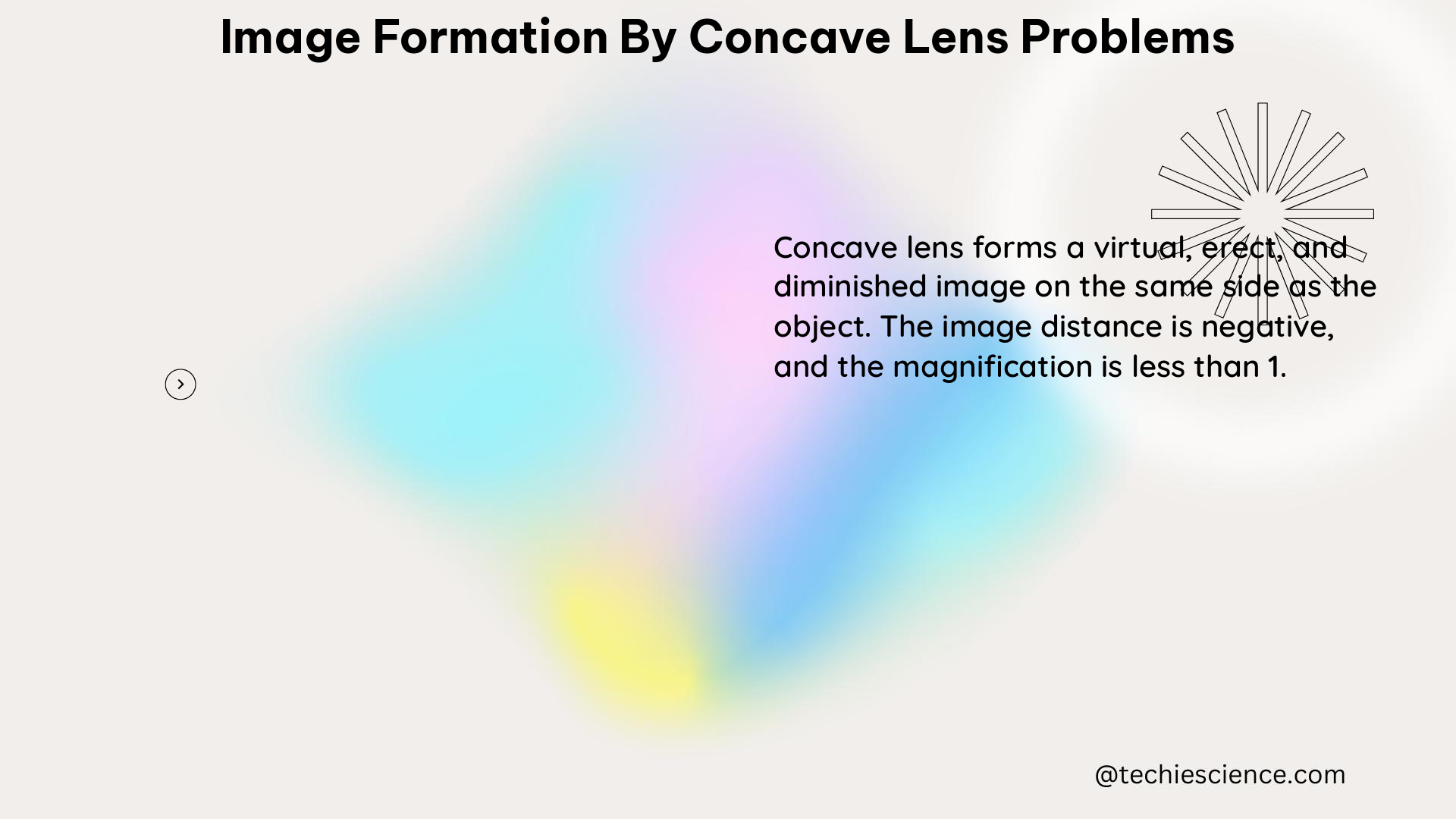Concave lenses are a fundamental component in the study of optics, and understanding their role in image formation is crucial for physics students. This comprehensive guide delves into the intricate details of image formation by concave lenses, providing a wealth of technical information, formulas, examples, and numerical problems to help you master this topic.
Understanding Concave Lenses
Concave lenses are diverging lenses, meaning they spread out light rays rather than converging them like convex lenses. This unique property of concave lenses results in the formation of virtual images, which are always upright and smaller than the original object.
Characteristics of Concave Lens Images
- Virtual Image: Concave lenses can only form virtual images, as the light rays appear to diverge from a point behind the lens.
- Upright Image: The image formed by a concave lens is always upright, regardless of the object’s position.
- Smaller Image: The image formed by a concave lens is always smaller than the original object.
The Lens Equation and Magnification

The relationship between the object distance (do), image distance (di), and focal length (f) of a concave lens is described by the lens equation:
1/f = 1/do + 1/di
where the focal length (f) of a concave lens is always negative.
The magnification (m) of the image formed by a concave lens can be calculated using the equation:
m = -di/do
The negative sign indicates that the image is virtual and upright.
Example Calculation
Let’s consider an example where an object is placed 32.7 cm from a concave lens with a focal length of -10.8 cm.
-
Calculating the image distance (di):
1/(-10.8 cm) - 1/(32.7 cm) = 1/di
di = -8.12 cm
The image is formed 8.12 cm behind the lens. -
Calculating the magnification (m):
m = -di/do = -(-8.12 cm)/(32.7 cm) = 0.25
The image is one-quarter the size of the object.
Image Formation by Concave Lenses: Data Table
The table below summarizes the image formation by a concave lens at different object distances:
| Object Distance (do) | Image Distance (di) | Magnification (m) | Image Type |
|---|---|---|---|
| do > -f | di < -f | m < 1 | Virtual, upright, smaller |
| do = -f | di = -∞ | m = 0 | Virtual, upright, same size |
| -f < do < 0 | -f < di < 0 | 0 < m < 1 | Virtual, upright, smaller |
| do = 0 | di = 0 | m = undefined | No image formed |
| do < 0 | di > 0 | m > 1 | Virtual, upright, larger |
This table provides a comprehensive overview of the image formation by a concave lens, highlighting the key characteristics of the image, such as its type, orientation, and size, based on the object distance.
Numerical Problems and Exercises
To further solidify your understanding of image formation by concave lenses, let’s explore some numerical problems and exercises:
- Problem: An object is placed 20 cm in front of a concave lens with a focal length of -15 cm. Determine the image distance and the magnification.
Solution:
– Using the lens equation: 1/f = 1/do + 1/di
– Substituting the values: 1/(-15 cm) = 1/20 cm + 1/di
– Solving for di: di = -30 cm
– Calculating the magnification: m = -di/do = -(-30 cm)/20 cm = 1.5
- Problem: A concave lens has a focal length of -12 cm. Where should an object be placed to obtain an image that is twice the size of the object?
Solution:
– Using the magnification equation: m = -di/do
– Substituting m = -2 and f = -12 cm, we get:
– -2 = -di/do
– do = di/2
– Substituting do = di/2 into the lens equation:
– 1/(-12 cm) = 1/(di/2) + 1/di
– Solving for di: di = -24 cm
– Calculating the object distance: do = di/2 = -12 cm
- Exercise: A concave lens has a focal length of -20 cm. Determine the image distance and magnification for an object placed:
a. 30 cm in front of the lens
b. 10 cm in front of the lens
c. 20 cm in front of the lens
These problems and exercises will help you apply the concepts of image formation by concave lenses and solidify your understanding of the topic.
Additional Resources
For further exploration and deeper understanding of image formation by concave lenses, consider the following resources:
Reference:
– The Mathematics of Lenses – The Physics Classroom
– 8.6 Image Formation by Mirrors | Texas Gateway
– Image Formation by Lenses | Physics – Lumen Learning

The lambdageeks.com Core SME Team is a group of experienced subject matter experts from diverse scientific and technical fields including Physics, Chemistry, Technology,Electronics & Electrical Engineering, Automotive, Mechanical Engineering. Our team collaborates to create high-quality, well-researched articles on a wide range of science and technology topics for the lambdageeks.com website.
All Our Senior SME are having more than 7 Years of experience in the respective fields . They are either Working Industry Professionals or assocaited With different Universities. Refer Our Authors Page to get to know About our Core SMEs.